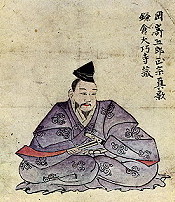East Sheen (SW London) Aikido and Kashima Shinryu Kenjutsu Dojo
 Robert Cowham (facing) demonstrating kenjutsu with Paul Smith taking ukemi
(Photo Phoebe Cowham) |
This is the home page for the Aikido and Kashima Shinryu Kenjutsu club based in East Sheen, SW London (near Mortlake, Barnes and Richmond) . The dojo is affiliated with Tetsushinkan dojo at MovingEast.
If you are interested, please let me know your details by emailing robert.cowham@gmail.com (or ringing 020 8876 1697 or 07785 292 719).
Aikido and Kashima Shinryu Kenjutsu
Aikido is about using mind, ki (energy) and body to deal with your attackers energy and redirect it. Kashima Shinryu is more direct and focuses acutely on how to use your body while responding to an attack. The combination addresses softness and yet trains the ability to respond to pressure.
It is suitable for men and women of all ages from mid-late teens upwards.
Our interests include softness and sensitivity of the body and how kenjutsu (sword work) brings this out and informs the taijutsu (unarmed movements) of aikido. We practise with shinai (leather covered bamboo swords) and bokken (wooden swords).
The class typically starts with stretching and other centering and energy development exercises such as qi gong (also known as chi kung). These help to relax, calm and focus the mind and body, and also develop ki (also known as qi/chi in Chinese see Wikipedia definition).
Martial effectiveness is studied through the focus and pressures of kenjutsu, and researching the development of the tanden (central point of the body).
The mental and psychological aspects are as beneficial as the physical training. How can we train to respond appropriately rather than have all our training leave us in an unguarded moment? Most of us are very unlikely to be physically attacked, and yet are typically "attacked" verbally or psychologically on a daily basis - how can we maintain our centre in such situations?
The benefits are both physical and mental, and include:
- greater flexibility, softness, fitness and coordination
- increased sensitivity and awareness, both of our bodies, our state of mind and our surroundings
- increased concentration and improved confidence.
The Club - Time and Location and Costs
The club meets on Monday evenings from 20.15 until 21.45 (in 2008 classes start on 28 January).
| Costs: | £8 per class, £6 for concessions. |
| Location: | The old United Reform Church (small hall) in Vernon Road, London SW14 (Google Maps link).
This is close to Mortlake station (on the Richmond-Waterloo line) (see www.tfl.gov.uk for Journey Planner). |
| What to wear: | Beginners can wear a track suit or loose fitting clothes to start with; unless of course you happen to have a judo (or other martial arts suit with a white belt) which would be ideal.
We practise in bare feet.
Once you have decided to practise regularly, you will be expected to buy yourself a judo suit. |
The Teacher
Robert Cowham has been studying Aikido since 1987. He studied in Italy and Holland before returning to London in 1989 and starting with Kanetsuka sensei (7th dan). He has studied Kashima Shinryu Kenjutsu since 1992 (with Paul Smith sensei of Tetsushinkan, and Inaba sensei of the Meiji Jingu Shiseikan) and is a yondan (4th degree blackbelt) in Aikido. His main teachers over the years have been Paul Smith sensei (5th dan) and Inaba sensei (8th dan). He has also studied regularly in Norway with Bjorn Eirik Olsen sensei (6th dan) and Suganuma sensei (8th dan), as well as various other teachers around the world. He also has an interest in Cheng Hsin as taught by Peter Ralston.
Robert was a founding director of MovingEast and is Assistant Instructor at Tetsushinkan dojo.
Links
Clubs and teachers with whom we have links:
- Tetsushinkan at Movingeast (Paul Smith), North London, UK
- Shiseikan Budojo (Inaba sensei), Meiji Jingu, Tokyo, Japan
- Battersea Dojo (Nicola Endicott), SW London, UK
- NatureWorks Dojo (Jessica Loeb), Central London, UK
- Free Form Aikido (Peri Macintosh), New Cross, SE London, UK
- Reimeikan Dojo (Bjorn Eirik Olsen), Tromso, Norway
- Tenshinkan Dojo (Atle Riise and Lars Lommel), Oslo, Norway
- Aikido of Eragny (Pascal Durchon), near Paris, France
- Darmstadt Aikido (Anita Koehler), Darmstadt, Germany



